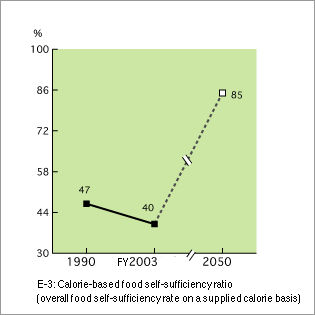ProjectsPast and current JFS projects
Indicators - Economy / Food
E-3. Calorie-Based Food Self-Sufficiency Ratio
1.Current Values40% (FY 2003)
2.Current Points
(out of a perfect score of 100 by 2050) 47 points
Calculation method:
(Current value - minimum value) / (2050 target value - minimum value) x 100
3. Explanation of Indicator
Japan depends upon overseas imports for its food supply; its food self-sufficiency ratio is 40%, the lowest of the OECD countries. In light of predictions that the world demand for food will rapidly increase, this system of excessive dependence on imports will become a big cause for concern in terms of ensuring food safety.
Moreover, the fact that there are many leftovers even while food is being imported is a situation that is a problem from the point of view of the fair allocation of resources. Japan's food self-sufficiency ratio must be improved for Japan to continue to exist sustainably and with a higher degree of fairness to other nations; we have selected it as an indicator.
4.Target for 2050
85%
5.Ideal for the Future
100%
6. Rationale for Ideal and Target Values
The Basic Plan for Food, Agriculture, and Rural Areas of Japan's Ministry of Agriculture, Forestry and Fisheries (Cabinet approval March 2000) has set the target value for 2010 at 45%. In order to attain this target there will have to be an average increase of 1% each year after 2005. On the assumption that such a rate of increase would continue after 2010, we can calculate that a target of 85% could be reached by 2050.
The ideal would be circumstances in which the domestic demand for calories could be met entirely (100%) even if imports from other countries were to be temporarily halted.
7. Source
Ministry of Agriculture, Forestry and Fisheries, Food Self-Sufficiency Ratio for Fiscal 2003
8. Notes
Percentage of total food calories supplied to the Japanese population that are met by domestic production. Additionally, "food mileage", an estimated value representing the amount of food imported multiplied by the distance between the exporting country and Japan, is a candidate for being an indicator given the environmental burden that transporting imposes.



